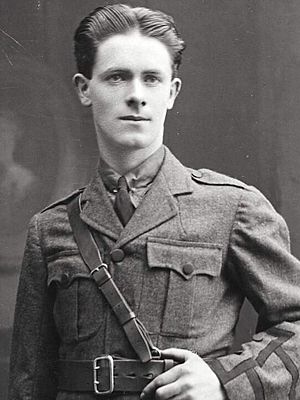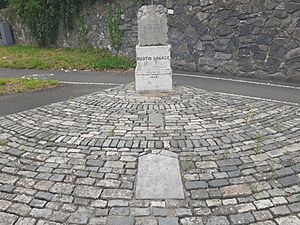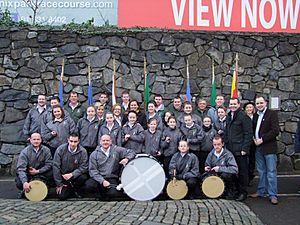Martin Savage facts for kids
Quick facts for kids
Martin Savage
Irish: Máirtín Sabhaois |
|
|---|---|
 |
|
| Born | 12 October 1897 Ballisodare, County Sligo, Ireland |
| Died | 19 December 1919 Ashtown, County Dublin, Ireland |
| Allegiance | Irish Republican Army, Irish Volunteers |
| Years of service | 1916–1919 |
| Rank | Officer |
| Unit | Dublin Brigade |
| Battles/wars | Easter Rising, Irish War of Independence |
Martin Savage was an important Irish soldier who lived from 1897 to 1919. He was an officer in the Dublin Brigade of the Irish Republican Army (IRA). The IRA was a group fighting for Ireland's freedom from British rule. Martin Savage came from Ballisodare in County Sligo. He died in a gunfight during an ambush in Ashtown, near Dublin, in 1919. This happened early in the Irish War of Independence.
Contents
Martin Savage's Early Life
Martin Savage was born on October 12, 1897, in Streamstown, Ballisodare, County Sligo. He was the youngest son of Michael Savage and Bridget Savage. His father, Michael, was known as a Fenian activist. Fenians were a group who supported Irish independence.
After finishing school, Martin worked as an apprentice grocer in Sligo Town. But he soon decided to dedicate himself to the fight for Ireland's freedom.
Joining the Fight for Irish Freedom
Martin Savage moved to Dublin in 1915. There, he joined the Irish Volunteers. This group was also working for Irish independence.
The Easter Rising
When he was just 18, Martin took part in the 1916 Easter Rising in Dublin. This was a major rebellion against British rule. He fought bravely at the Four Courts building.
After the fighting, the British Army captured him. He was held in Richmond Barracks. On April 30, 1916, he was sent to a prison camp in Knutsford, England. About 200 other captured Irish soldiers were sent there too.
Becoming an IRA Lieutenant
After his release, Martin returned to Dublin. He quickly rejoined the fight for independence. He became a Lieutenant in the 2nd Battalion of the Dublin Brigade. This was part of the Irish Republican Army (IRA).
Within the republican groups, Martin was known as a quiet and popular young man. He was trusted by important leaders like Dan Breen, Seán Treacy, and Seán Hogan.
The Ashtown Ambush
On December 19, 1919, Martin Savage and ten other Volunteers met. They planned to attack Lord French. He was the British Viceroy and the top commander of the British Army in Ireland. Lord French was returning from a party at his country home.
Planning the Attack
Martin Savage was not originally supposed to be part of the ambush. But he met Dan Breen and Seán Hogan by chance. Martin insisted on joining the attack force. Seán Hogan tried to talk him out of it at first. But he eventually agreed and gave Martin an automatic pistol.
The group's spy had found out how Lord French would travel. He would be in the second car of an armed convoy. The convoy included a motorcycle outrider and three cars. Lord French would travel from Ashtown railway station to his lodge in Phoenix Park, Dublin.
The Day of the Ambush
On the day of the ambush, Martin Savage went to work as usual. He then secretly left early in the morning. He met the other men at Fleming's Pub in Drumcondra.
They left Drumcondra in small groups to avoid suspicion. They cycled through Phibsboro and up the Cabra Road. Then they met again at Kelly's Public House in Ashtown. This pub is now called the Halfway House.
Around 11:40 a.m., Lord French's train arrived at the station. The men left the pub and took their positions. They waited along the crossroads at Ashtown.
The Plan and the Fight
The plan was for Martin Savage, Tom Kehoe, and Dan Breen to push a hay-cart. They would push it halfway across the road. After the outrider and the first car passed, they would push it all the way across. This would block the road completely. They believed Lord French would be in the second car. They planned to attack this car with Mills Bombs (grenades) and rifle fire.
As they pushed the hay-cart, a police officer from the Royal Irish Constabulary (RIC) saw them. He told them to move. One of the Volunteers threw a grenade at him. It didn't explode, but it hit the officer's head. He was knocked out. The officer was then moved off the road, and the attack continued.
The Gun Battle
Minutes later, the convoy appeared. The attack began. The second car, which was their target, swerved off the road. But the attackers did not know that Lord French was actually in the first car. That car managed to drive through the blockade.
The people in the second car were Lord French's guards. They started shooting back. Then, the third car arrived on the other side of the cart. Its occupants also began firing rifles at the exposed Volunteers.
In the gunfight, Dan Breen was shot in the leg. Seconds later, Martin Savage was hit in the neck and fell. He was badly wounded. He died in Dan Breen's arms. His last words to Breen were, "I'm done, but carry on...."
Tom Kehoe and the wounded Dan Breen managed to carry Martin Savage's body away from the road. They took him back to Kelly’s Pub while the gun battle continued. Two RIC police officers and a driver were also wounded in the fight.
At this point, the British military began to leave the scene. They continued towards Phoenix Park. The IRA unit knew that British reinforcements would soon arrive. So, they spread out to safe houses in Dublin. Paddy Daly helped Breen onto his bike and took him to a safe house in Phibsboro. There, a doctor treated his wounds.
The Newspaper Incident
The next morning, the Irish Independent newspaper published an article. It called the attackers "assassins" and used words like "criminal folly" and "murder." The IRA men felt this insulted their dead friend, Martin Savage. So, they decided to attack the newspaper's offices.
On Sunday evening, about twenty to thirty IRA men entered the Independent offices. They damaged the printing machines. Despite this, with help from other Dublin newspapers, the Independent was able to print the next day. The newspaper owners were later given money for the damage. According to Dan Breen, the Independent and other Dublin newspapers never called the IRA "murderers or assassins" again.
Martin Savage's Funeral

The British military took Martin Savage's body. An official investigation was held into his death. His brother and his employer, William Kirk, attended. Kirk described Martin as "a steady, sober and industrious young man, gentlemanly in manner and extremely courteous."
After the investigation, Martin's body was given to his family. His remains stayed overnight at Broadstone Station. Then, they left for Sligo. A large crowd met the train at Collooney railway station.
His coffin was covered with an Irish Tricolour flag. It was carried over two miles on shoulders to his family's burial ground. He was buried with military honors in his hometown of Ballisodare, County Sligo.
Dan Breen wrote about the funeral. He said the procession was "several miles long." The local priest said the final prayers. Armed police surrounded the graveyard. Breen felt this was the best tribute they could give to a brave soldier, even if the police didn't mean it that way.
Martin Savage's Legacy

In 1948, the National Graves Association put up a memorial for Savage. It is near where the ambush happened at Ashtown Roundabout. Every year, people gather there to remember his death.
Many streets and public places have been named after him. These include Martin Savage Place in County Meath. There is also Martin Savage Road and Martin Savage Park in County Dublin. This park is home to the St. Oliver Plunkett's Eoghan Ruadh GAA club. A place called Martin Savage Terrace is near the center of Sligo Town.
The Ashtown Fianna Fáil Cumann, a local political group, holds an annual event. It takes place on the Sunday after the anniversary of his death at the Ashtown memorial. Since 2002, the Sinn Féin Joe McDonnell Cumann also holds an annual gathering on the anniversary of his death.
The Coen/Savage (East Sligo) Sinn Féin Cumann also holds a wreath-laying ceremony. This happens every Easter Sunday morning at Martin Savage's graveside in Ballisodare, County Sligo.



